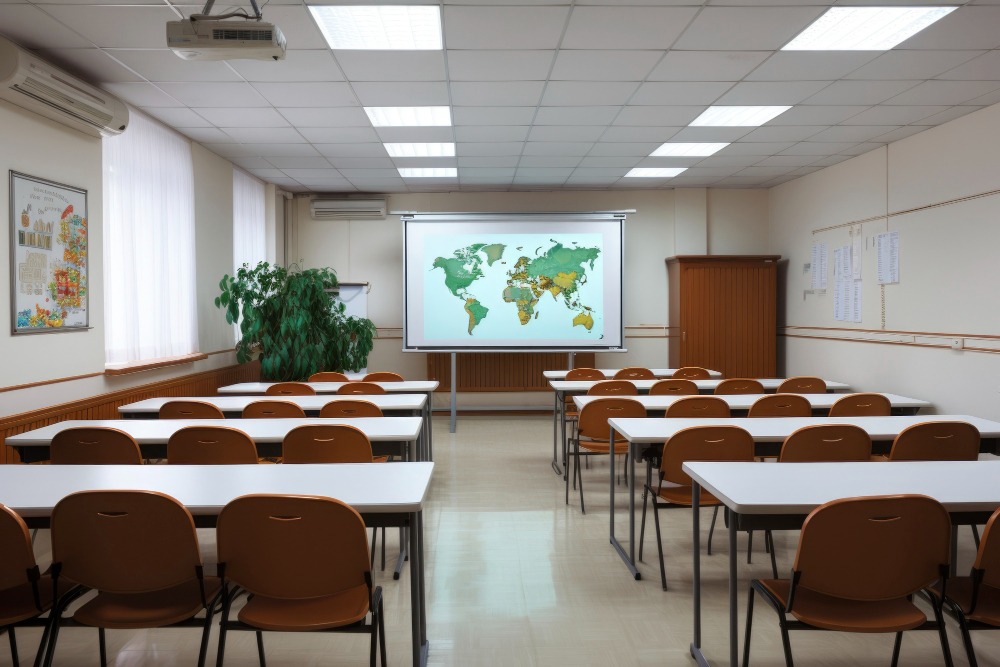The instructive scene has seen a surprising change over the past few decades. The once omnipresent chalkboards, images of conventional educating, are being supplanted by computerized screens, intelligently whiteboards, and a plenty of developing innovations. This move is not just approximately swapping devices; it means a significant alter in how instruction is conveyed and experienced. Joining rising advances in advanced classrooms is vital for planning understudies for a future ruled by quick mechanical advancements.
The Advancement of Classroom Technology
The travel from chalkboards to code reflects the broader innovative advancement in instruction. Chalkboards, which overwhelmed classrooms for centuries, were the essential medium for instructors to show data and understudies to lock in with learning fabric. The presentation of overhead projectors and at that point computers started to alter this energetic, advertising more intuitively and visual ways to display information.
In later a long time, the approach of tablets, intuitively whiteboards, and cloud-based learning stages has encourage revolutionized the classroom environment. These devices have made learning more locks in, open, and personalized. The integration of innovations like virtual reality (VR), increased reality (AR), fake insights (AI), and coding into instruction is the most recent stage of this advancement, advertising uncommon openings for improving the learning experience.
Enhancing Engagement and Interactivity
One of the most noteworthy benefits of joining rising advances in the classroom is the improvement of understudy engagement and interactivity. Conventional instructing strategies frequently battle to capture the consideration of digital-native understudies who are acclimated to intuitively and multimedia-rich substance. Developing advances address this challenge by making learning more immersive and engaging.
For case, VR and AR can bring unique concepts to life by giving immersive encounters. Understudies can investigate verifiable destinations, conduct virtual science tests, or visualize complex scientific issues in three measurements. These encounters make learning more unmistakable and important, cultivating a more profound understanding of the subject matter.
Personalized Learning Experiences
Emerging innovations moreover empower personalized learning encounters, catering to the differing needs and learning styles of understudies. AI-powered versatile learning stages can analyze students’ execution in real-time and alter the substance and trouble level in like manner. This personalized approach guarantees that understudies get the right level of challenge and bolster, improving their learning outcomes.
Moreover, computerized devices permit understudies to learn at their claim pace. Online courses, intelligently reenactments, and instructive apps give adaptable learning alternatives that can be gotten to anytime, anyplace. This adaptability is especially advantageous for understudies with distinctive learning speeds and those who require extra hone or enrichment.

Developing Future-Ready Skills
Incorporating rising advances into the classroom is basic for creating future-ready abilities. The present-day working environment progressively requests capability in advanced abilities, basic considering, problem-solving, and collaboration. By joining advances like coding, mechanical autonomy, and information analytics into the educational programs, teachers can prepare understudies with these fundamental skills.
Coding, in specific, has gotten to be a principal aptitude in today’s advanced age. Instructing understudies to code not as it were plans them for potential careers in innovation but moreover upgrades their coherent considering and problem-solving capacities. Mechanical autonomy and computerization ventures energize imagination and development, permitting understudies to plan and construct their possess arrangements to real-world problems.
Fostering Collaboration and Communication
Emerging innovations moreover cultivate collaboration and communication among understudies. Online collaboration devices, such as Google Workspace, Microsoft Groups, and different instructive stages, empower understudies to work together on ventures, share thoughts, and give criticism in real-time. These apparatuses reflect the collaborative nature of present day work environments, planning understudies for future proficient environments.
Furthermore, social learning stages and discourse gatherings empower peer-to-peer learning. Understudies can lock in in significant talks, inquire questions, and offer assistance each other get it complex concepts. This collaborative approach not as it were upgrades learning but moreover builds basic communication and collaboration skills.
Addressing Value and Accessibility
Integrating rising advances in the classroom can moreover address issues of value and availability. Advanced learning assets can give break even with openings for all understudies, notwithstanding of their geological area or socio-economic foundation. Online courses and e-books can be gotten to by understudies in inaccessible or underserved ranges, guaranteeing that they get quality education.
Assistive innovations, such as speech-to-text program, screen perusers, and versatile consoles, bolster understudies with inabilities, empowering them to take an interest completely in the learning prepare. These innovations advance comprehensive instruction, guaranteeing that each understudy has the devices and assets they require to succeed.
Challenges and Considerations
While the integration of rising innovations offers various benefits, it moreover presents challenges that require to be tended to. One of the essential concerns is the advanced partition, where unequal get to to innovation can worsen existing instructive disparities. Schools and policymakers must work together to guarantee that all understudies have get to to the essential gadgets and web connectivity.
Privacy and security are moreover basic contemplations. The utilize of computerized instruments and online stages includes the collection and capacity of understudy information. It is basic to execute vigorous information assurance measures and guarantee compliance with security directions to protect students’ information.
Additionally, the fruitful integration of innovation requires continuous proficient improvement for teachers. Instructors require preparing and back to viably utilize modern innovations and join them into their instructing hones. Contributing in proficient improvement programs and cultivating a culture of nonstop learning among teachers is vital for maximizing the benefits of innovation in education.
Conclusion
The move from chalkboards to code means a transformative move in instruction, driven by the integration of rising innovations in the classroom. These innovations upgrade engagement, personalize learning encounters, create future-ready abilities, cultivate collaboration, and advance value and availability. Be that as it may, tending to challenges such as the advanced isolate, security concerns, and the require for proficient improvement is fundamental for effective execution. By grasping these advances, teachers can get ready understudies for a quickly advancing world, preparing them with the aptitudes and information required to flourish in the future. The classroom of tomorrow is here nowadays, and it is fuelled by advancement and innovation.
Dr. Subhash University is the best university in Gujarat which offers many programmes, best university in Gujrat for Engineering| best university in Gujrat for BBA| best university in Gujrat for MBA |best university in Gujrat for B.com |best university in Gujrat for M.com| best university in Gujrat for Nursing |best university in Gujrat for BSC |best university in Gujrat for MSC| best university in Gujrat for BCA |best university in Gujrat for MCA |best university in Gujrat for Physiotherapy |best university in Gujrat for BA |
